
I normally travel while it is warm at my destination, but this year my travel companion's work schedule pushed our trip to Turkey back to early October. I knew we would have cool nights, at the very least. I have been feeling the lack of an early Fall jacket for mid-50s to low-60s (too cold for a denim jacket, but not cold enough for a coat) for a while, so the trip provided the impetus for me to make a jacket as the centerpiece of my wardrobe.
I didn't like much in Burda's August 2010 issue, but I just *loved* the details on the Burda 08-2010-113 jacket (pattern available for purchase at BurdaStyle at the link--I suppose this is the good thing about the website "transition"): the cool variation on a standing collar, interesting slight V neckline that doesn't compromise warmth, princess seams (accomplished with a side panel--there is no side seam), cropped length, unusual diagonal dart, rounded front hemline. So many great details. I don't really get the extended front shoulder for a faux yoke-ish look, but it doesn't seem to affect fit or wear so whatevs. And it's a petite! Although, as they have informed us "petite" only means shorter; it is not altered to accommodate, for instance, a petite's narrower shoulders and for this particular pattern I think they forgot to shorten the sleeves.
 I planned a purple and green wardrobe so that everything would go with the fuschia lambswool for this jacket, purchased from fabric.com when they were selling the Vera Wang Lavendar Label fabrics for $1.95/yd at the beginning of the year. The lining is the olive silk/rayon slipper satin from the same collection. I pre-treated by laying flat in the bathtub and sort of sliding it around without crumpling, hanging dry, and then washing by machine. It didn't come out with the surface intact, but it is fine for lining. I love the way the two colors look together. The buttons are from a Fabric Mart 4 pound bag I split with Cidell. I thought they were super ugly and didn't plan to take any, but she urged me to. I didn't have anything else that would work for the jacket so I used these as "temporary" buttons, but they have totally grown on me. I think they suit the tweedy vibe of the fabric and style very well.
I planned a purple and green wardrobe so that everything would go with the fuschia lambswool for this jacket, purchased from fabric.com when they were selling the Vera Wang Lavendar Label fabrics for $1.95/yd at the beginning of the year. The lining is the olive silk/rayon slipper satin from the same collection. I pre-treated by laying flat in the bathtub and sort of sliding it around without crumpling, hanging dry, and then washing by machine. It didn't come out with the surface intact, but it is fine for lining. I love the way the two colors look together. The buttons are from a Fabric Mart 4 pound bag I split with Cidell. I thought they were super ugly and didn't plan to take any, but she urged me to. I didn't have anything else that would work for the jacket so I used these as "temporary" buttons, but they have totally grown on me. I think they suit the tweedy vibe of the fabric and style very well.I altered the pattern to include a swayback adjustment, shorten the sleeves (I like jackets to have knuckle length sleeves, but these were ridiculous), and a small bust adjustment by both narrowing the dart and flattening the bust curve of the side piece (as demonstrated here).
I pretreated the wool fabric by washing and drying in the washing machine and dryer. Yes, I am that brutal. After how easily ruined the VW slipper satin was, and how ridiculously much the silk chiffon bled (another project in the travel wardrobe possiblities), I wanted to make sure the fabric was worth sewing. Fortunately, it did beautifully and did not shrink very much, if at all.
The wool remained very soft after coming out of the washing machine, so I fused all the pieces with a lightweight knit interfacing to give it some body and hopefully cut down on wrinkling. Boy, is fusing boring.
The jacket is relatively easy to sew.
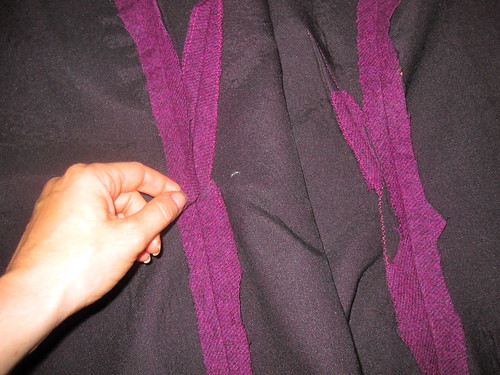 The very long diagonal bust darts require a little strategery, especially where they intersect with the princess seams. I had to clip the seam allowances to layer everything properly. In the end, my darts are not quite the same length. Oops.
The very long diagonal bust darts require a little strategery, especially where they intersect with the princess seams. I had to clip the seam allowances to layer everything properly. In the end, my darts are not quite the same length. Oops.The VW wool eased nicely, which was a huge bonus. For the princess seams, I ran a line of basting stitch just outside the stitching line; pulling up on those threads made it very easy to ease the pieces together without puckers.
I was very trepidatious about the sleeves after my Tuxedo Jacket of Doom experience. The body and especially the notched collar of the Tuxedo Jacket of Doom are beautiful but the sleeves are so bad that I will never wear it. There are puckers in the sleevecap (my fault, I suppose) and the sleeve folds and spirals in the most horrible way (not my fault, I don't think). The jacket is unwearable after all the work I put in. I haven't had a problem with Burda sleeves on non-outerwear (innerwear?), but that jacket was just so beyond that it scarred me!
First issue was the shoulders were way, way too wide. I do have narrow shoulders compared to the sloper used by the pattern companies, but I don't usually have too much of an issue in Burda. I trimmed about half inch off the shoulder edge of the jacket before setting in the sleeves. Because it is an outerwear jacket, which is not meant to fit like clothes but over them, I decided to leave the shoulder a tiny bit extended versus where I would place a blouse. In the end, I wish I had brought the shoulder in a full inch to my natural shoulder line, but it's not a big deal.
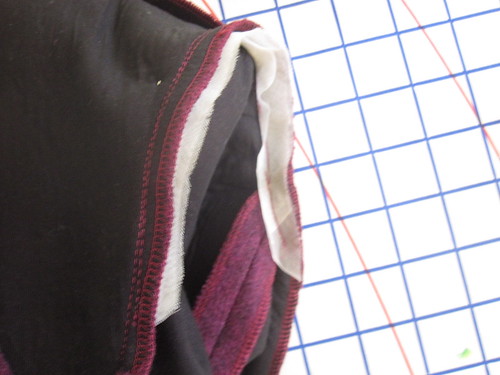 I planned to use shoulder pads but with the slightly extended shoulder and soft fabric (even after fusing) I decided it could also use a sleeve head. Using this information from Claire Shaeffer's Couture Sewing (thank you Google Books!) I cut a piece of silk organza on the bias 8 1/2 inches long and 1 1/2 inches wide, folded in half, pinned over the sleeve at the armscye seam with the fold extending slightly over the seamline and hand-sewed in place (could have used machine but after how much easing the sleevecap required I didn't want to jinx my smooth insertion).
I planned to use shoulder pads but with the slightly extended shoulder and soft fabric (even after fusing) I decided it could also use a sleeve head. Using this information from Claire Shaeffer's Couture Sewing (thank you Google Books!) I cut a piece of silk organza on the bias 8 1/2 inches long and 1 1/2 inches wide, folded in half, pinned over the sleeve at the armscye seam with the fold extending slightly over the seamline and hand-sewed in place (could have used machine but after how much easing the sleevecap required I didn't want to jinx my smooth insertion). 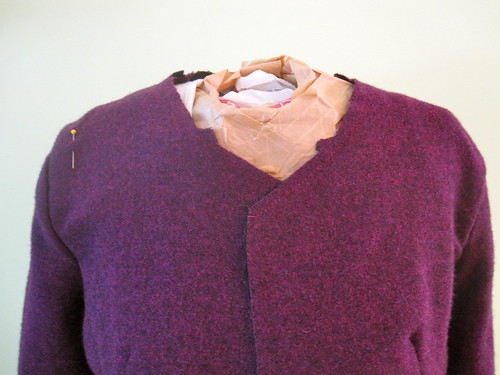 When the armscye seam is pressed toward the sleeve the sleeve head folds over on itself because of the fold extending beyond the seamline so it is four layers. I really don't know that it made a huge difference--in the photo at left, the side with the pin has a sleeve head and the other side doesn't. But at least I tried a new technique!
When the armscye seam is pressed toward the sleeve the sleeve head folds over on itself because of the fold extending beyond the seamline so it is four layers. I really don't know that it made a huge difference--in the photo at left, the side with the pin has a sleeve head and the other side doesn't. But at least I tried a new technique!The back of the sleevecap needed a large amount of easing, but here I was working with wool so it went in a little easier than the TJOD. I ran a line of basting stitching near the seamline (within the seam allowance), pinned, and then pulled the basting stitch to ease. Then I hand-basted the back sleevecap in place. Then I sewed with the sleeve toward the feed dogs so they would take up some of the ease, counting on my hand-basting to keep it flat. It worked! I was inordinately pleased.
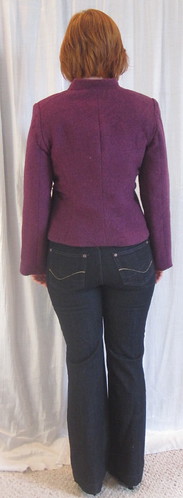
I don't really understand the point of the tiny back vent, as this is a cropped jacket, and it isn't really a proper vent anyway, just an unsewn bit of the center back seam. So I sewed the CB seam completely and dispensed with the vent.
The pattern is drafted with a patch pocket with flap at the waist and a welt pocket at the breast. I didn't want a breast pocket and I wasn't keen on the flapped pockets--seemed too fussy in my fabric. I did want pockets, however--you have to have a place to keep your gloves!
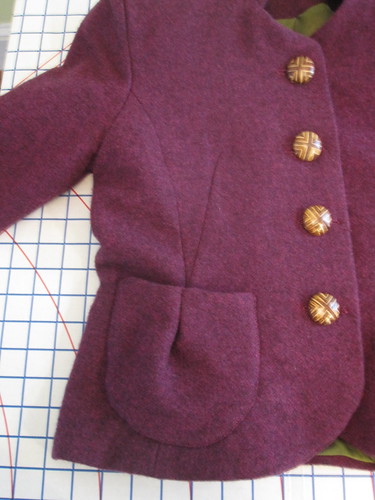 I didn't want a flat pocket because then the gloves would create an unattractive pooch, so I used the pleated pocket from Simplicity 2728. I don't think there's actually room to put a glove in each pocket without distorting the look, but I really like the pleated pocket, and spent some time making sure the pleat seamline of the pocket matched up with the princess seamline of the jacket.
I didn't want a flat pocket because then the gloves would create an unattractive pooch, so I used the pleated pocket from Simplicity 2728. I don't think there's actually room to put a glove in each pocket without distorting the look, but I really like the pleated pocket, and spent some time making sure the pleat seamline of the pocket matched up with the princess seamline of the jacket.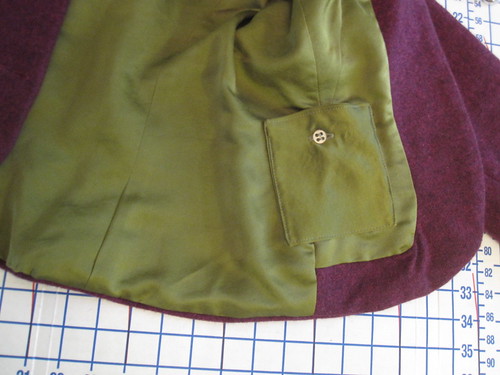 Since this was a travel jacket, I contemplated whether I wanted a zipper breast pocket in the lining as a place to securely hold a credit card, but decided that the fabric was too thin and there would clearly be a credit card sitting over my boob. Obvious security precautions shout "I am a tourist with valuables! Please rob me!" So I just put in a button internal pocket large enough to hold business cards in my normal life and a credit card in travel life.
Since this was a travel jacket, I contemplated whether I wanted a zipper breast pocket in the lining as a place to securely hold a credit card, but decided that the fabric was too thin and there would clearly be a credit card sitting over my boob. Obvious security precautions shout "I am a tourist with valuables! Please rob me!" So I just put in a button internal pocket large enough to hold business cards in my normal life and a credit card in travel life.I have given up on professional-type jackets as each one I've sewn has been a disaster. However, I have had plenty of success with outerwear so I thought of this as outerwear in the construction.
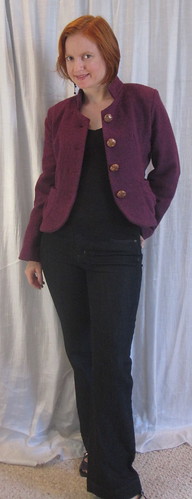 I sewed this jacket in a little over a week, breaking up the construction into small tasks and setting goals for each evening. It was great to feel so productive, but that level of organization is not sustainable in my life, LOL. I have more outerwear pieces on the horizon for this winter. After three winters of heavy wear my green coat is completely dead at this point--threadbare and irretrievably filthy, so that needs to be replaced. I hope I can be as diligent for future projects as for this one!
I sewed this jacket in a little over a week, breaking up the construction into small tasks and setting goals for each evening. It was great to feel so productive, but that level of organization is not sustainable in my life, LOL. I have more outerwear pieces on the horizon for this winter. After three winters of heavy wear my green coat is completely dead at this point--threadbare and irretrievably filthy, so that needs to be replaced. I hope I can be as diligent for future projects as for this one!I was beyond pleased with this jacket when I finished it, and it performed very well on my trip to Turkey. There is some slight pilling of the fabric on the inner sleeve and side where the sleeve rubs against the jacket, but it is noticeable only up close. Considering I wore this nonstop for 10 days, which simulates nearly an entire season of wear (10 days for 12 hours/day is 120 hours; normally I wear a coat maybe 2 hours/day, so that is the equivalent of 60 days of wear) I can say that the VW lambswool is of good quality!
All photos are here and the pattern review is here.



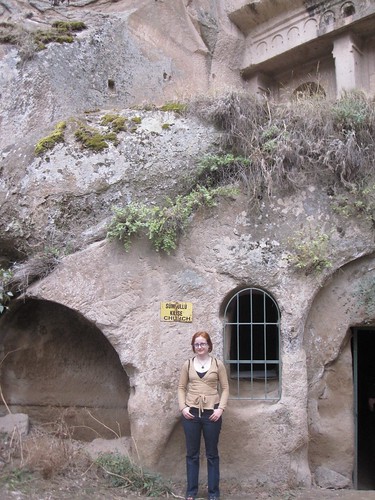
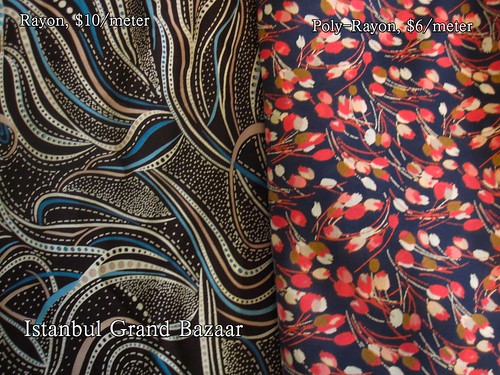

.jpg)









































































.jpg)















